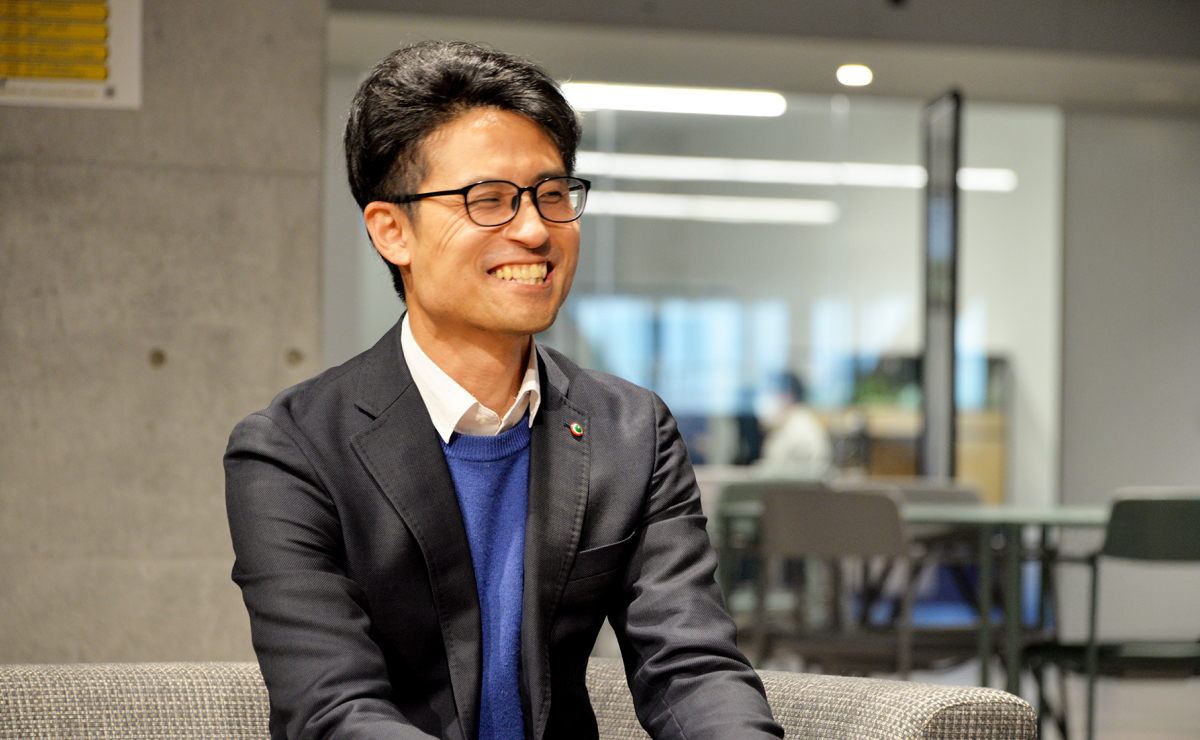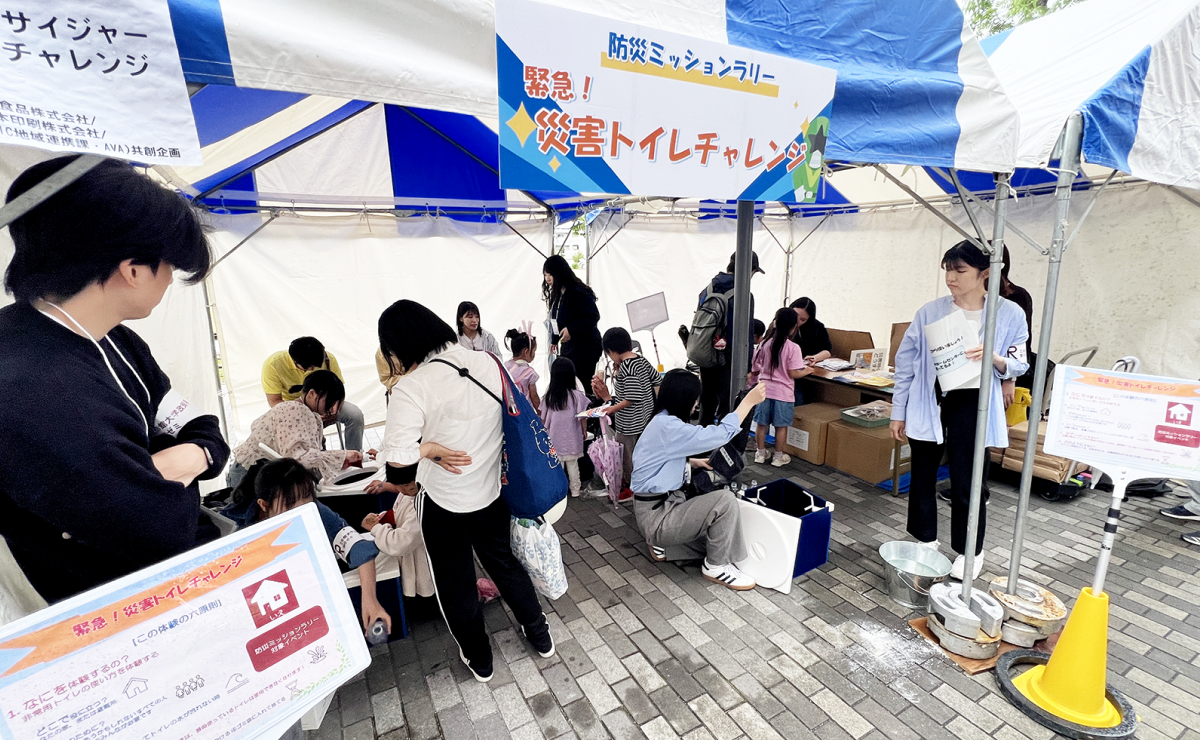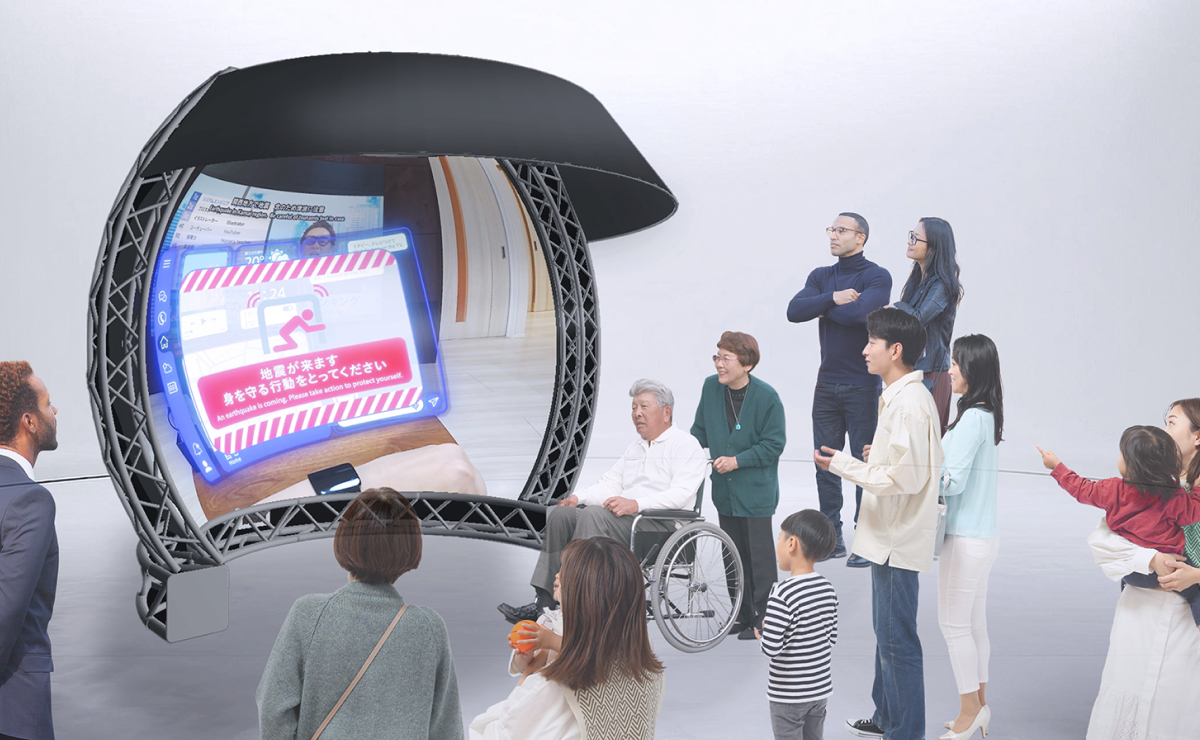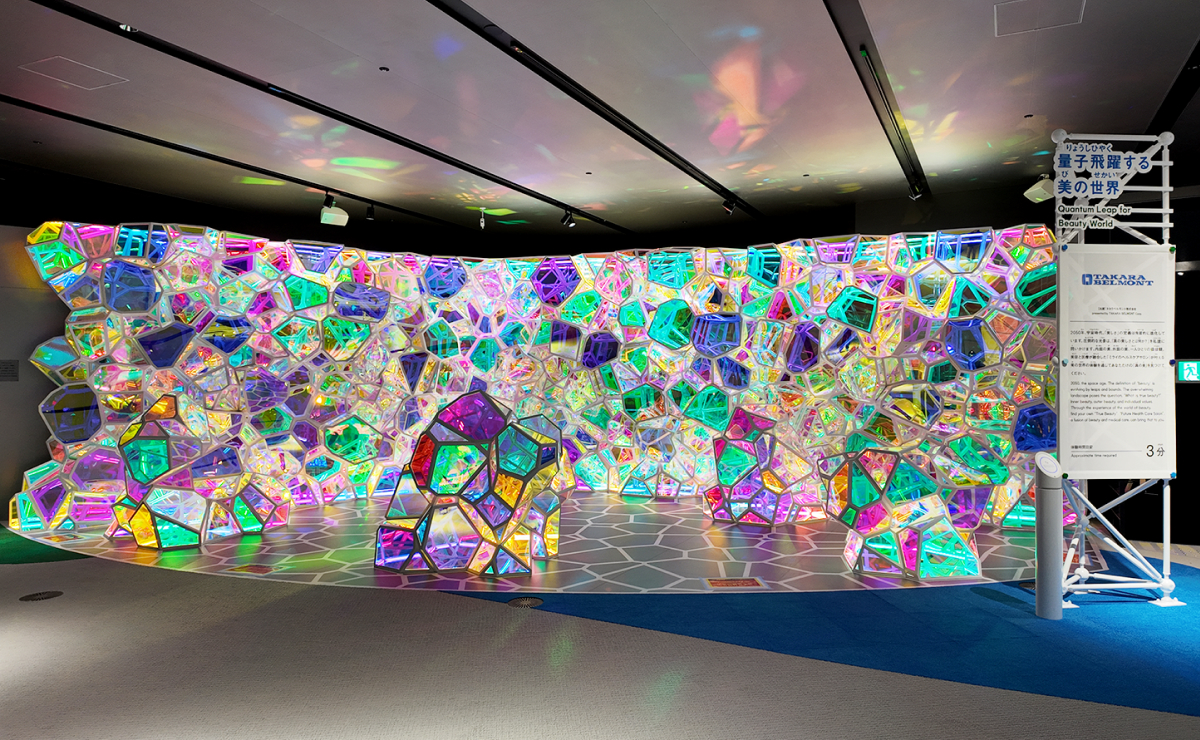World Expo Osaka-Kansai 2025 opened in April 2025. Its primary theme, “Designing Future Society for Our Lives,” overlaps with Ritsumeikan University's efforts to realize the ideal society of the future based on the R2030 Academy Vision.
As researchers, some faculty members from Ritsumeikan University are also participating in the Expo, which “serves as a testing ground for the future.” We sat down with College of Policy Science Associate Professor Yusuke Toyoda, who is supervising an exhibition where visitors can experience the future of disaster management, and College of Policy Science Associate Professor Miya Yamade, who designed the booth on the vision for healthcare in the year 2050, to ask them about their initiatives at the Expo and what they hope the event will achieve.
Creating mechanisms to enhance local disaster preparedness
Associate Professor Yusuke Toyoda specializes in community-based disaster management and disaster education. He is conducting research on how to implement effective disaster management activities in the face of the declining birthrate, aging population, and weakening of relationships among local residents.

Participation in community activities by local residents is low, especially among the younger generation, so it is necessary to get them involved in disaster management activities. Associate Professor Toyoda is currently working on disaster management events for children because these events can also educate the parents of the participating children about disaster preparedness. “I am thinking about ways to get people to participate in disaster management activities that are easy to join, such as disaster management games and events, in order to deepen their connections with the community, and then get them to take the next step and participate in more serious disaster management drills,” explains Associate Professor Toyoda.
As a practical application of his research, Associate Professor Toyoda and his seminar students run a disaster management booth for children every year at Ibaraki x Ritsumeikan Day, a joint community exchange event of Ritsumeikan University and Ibaraki City, Osaka Prefecture. In 2024 as well, Associate Professor Toyoda and his seminar students ran a booth (in collaboration with the Crisis Management Office of the Ibaraki City General Affairs Division) to let visitors experience how to use an emergency toilet. This was held as part of the Disaster Management Mission Rally, the name of the Ibaraki x Ritsumeikan Day Expo Co-Creation Challenge project. He explains that this is what led to him supervising the "Disaster Management: Uniting for a Safer Tomorrow" exhibition at the Expo.
“Seiryo Electric, one of the participating companies in the Disaster Management Mission Rally, deals in disaster management and information communication systems. They asked me to supervise the Expo exhibition because they needed expert advice to ensure that the content would align with national policies and trends in community-based disaster management.

The "Disaster Management: Uniting for a Safer Tomorrow" exhibition, supervised by Associate Professor Toyoda, will be on display from May 13 - May 19, 2025 as part of the Future Life Expo’s "Future Life Experience," a series of events where visitors can experience what life will be like in the future. The exhibition is based on the concept of the future of disaster management 10 years from now, and I hope it will provide an opportunity for visitors to realistically experience the future of evacuations supported by new technologies. I think people can expect that this is how different future evacuations will be.”
Collaboration between private companies and researchers to envision the future of disaster management
In supervising the exhibition, Associate Professor Toyoda placed particular importance on mutual aid. Although AI, robots, drones, and other technologies are being developed in rapid succession for use in disaster management, the importance of human connections remains unchanged. Associate Professor Toyoda, who believes that technology will not replace human connections but strengthen them, states that he kept in mind how technology and people interact when supervising the exhibition.

According to Associate Professor Toyoda, the newly formed relationship with Seiryo Electric was a great stimulus not only for World Expo Osaka-Kansai 2025, but also for future research. He recounts:
“I was amazed at the variety of ideas for disaster management technology that came out of working with Seiryo Electric. Although we did not use it for the Expo, one idea that arose was a pet robot that could play an active role in evacuation guidance in the event of a disaster. Having a pet robot as a member of the family to help out in the event of a disaster is reassuring. It is a great idea, and in response, I proposed that the pet robots could be connected to each other with a communication link. When there is a major disaster, the Self-Defense Forces and other government rescue services do not arrive immediately. Communication between robots could facilitate local rescue efforts, for example, when young people go to help those elderly people who have not yet been evacuated. This is another way we can support mutual aid by combining technology and research.”
Furthermore, Associate Professor Toyoda says that his work on the Expo has led him to strongly consider the relationship between technology and community-based disaster management. “So far, our research has focused on deepening connections between people in the local community and getting them to participate in disaster management activities. In addition to that, I am now thinking about the extent to which we can provide support for community-based disaster management issues by introducing technology, and conversely, where we should focus on interpersonal cooperation as well as the kinds of technologies that would be acceptable to local residents." In this way, Associate Professor Toyoda expressed his ambition to propose the most effective ways to connect people and technology for the sake of community-based disaster management.
The pursuit of beauty in life in outer space
Associate Professor Miya Yamade specializes in urban planning and community design, and one of her research topics is space architecture. Currently, space development work around the world focuses on technological development, but Associate Professor Yamade also hopes to incorporate beauty and fun into the design of space architecture to improve the quality of life (QOL) in space.
“Gravity on Earth is completely different from that in space, so I think we need to propose designs that differ from those on Earth. For example, since the moon's gravity is one-sixth that of Earth, we might want to design higher ceilings or stairs with taller steps than on Earth. I am trying to identify the optimal designs by interviewing astronauts who have actually been to space,” explains Associate Professor Yamade.

Associate Professor Yamade became involved with the Expo precisely because of her research on space architecture. She applied and was accepted for a research grant from the Union Foundation for Ergodesign Culture for a study examining the possibilities of space interior design. This caught the eye of the president of Takara Belmont Corporation, the foundation's external auditing company, and she was asked to handle the design and architecture of the booth in the Osaka Healthcare Pavilion. “I think there was a good fit between Takara Belmont's slogan ‘Rise into beauty, walk into life’ and my desire to pursue beauty in space development,” recalls Associate Professor Yamade.
Beauty in 2050 is something we will create by ourselves
Associate Professor Yamade was asked to design a health care salon for the year 2050 as “she saw fit.” Inspired by inflatable structures that can be folded up small enough to carry into space, she based her design on the concept of an astronaut on a space exploration mission finding a crystal cave.

"Actual inflatable structures are made by assembling several similar shapes that can be folded into small pieces, but for the Expo booth, I dared to use different shapes for each of the acrylic panels that make up the crystals in order to express the diversity of beauty,” explains Associate Professor Yamade.
Associate Professor Yamade hopes that visitors to the pavilion will take pictures of themselves reflected in the crystals, stating: “As a researcher, I value my alone time, but I suspect that many people are pressed for time every day and find it difficult to take time to engage with themselves. I want the Takara Belmont booth to be a space where people can do just this.”

In fact, Associate Professor Yamade confides that she initially considered turning down the Expo design offer because she thought it would cut into her research time. “Looking back, I’m really glad I decided to work on this project. The Takara Belmont booth I designed for the Expo is the culmination of my own research on space architecture because it directly connects to the interior design of space architecture that enhances QOL in space.”
Associate Professor Yamade also recalls that, thanks to the Expo, she learned about the many interesting initiatives that Takara Belmont is working on. For example, the company's carbonated scalp serum is a product that was developed in pursuit of providing a pleasant feeling (QOL) in addition to being effective. This is a technology that can be applied not only to space architecture but also to research on disaster recovery in Fukushima, where Associate Professor Yamade has been working for more than 10 years. There is a possibility that the connections she established this time could also lead to more joint research.
Expanding and accelerating research based on the Expo initiatives
As researchers, Associate Professors Toyoda and Yamade both became deeply involved in World Expo Osaka-Kansai 2025. So, what does the Expo mean to both of them?
Associate Professor Toyoda told us that his collaboration with company engineers afforded him with a good opportunity to think about the future. “Conventional research on disaster management tends to focus on how to mitigate damage from disasters that have already occurred, but my work on the Expo project, which aims to envision a safer future, has allowed me to incorporate an exciting, positive perspective into my research.”
Meanwhile, Associate Professor Yamade cited the importance of connections between people. “I think it was very meaningful to get to know people from different fields, including my partners at Takara Belmont and Junko Koshino, the designer who conceived the costumes for the exhibit booth staff. I believe that the connections made at this Expo will contribute to the development of research over the next 20 to 30 years. I also hope that my work on the Expo will send a message to students that if you enjoy life and try new things, a path will open up for you.”
Associate Professors Toyoda and Yamade both talked about how their participation in the Expo has given them ideas for further expanding upon their own research. With these co-creation efforts at the Expo serving as a new source of energy, we look forward to seeing how their research will greatly accelerate into the future.

